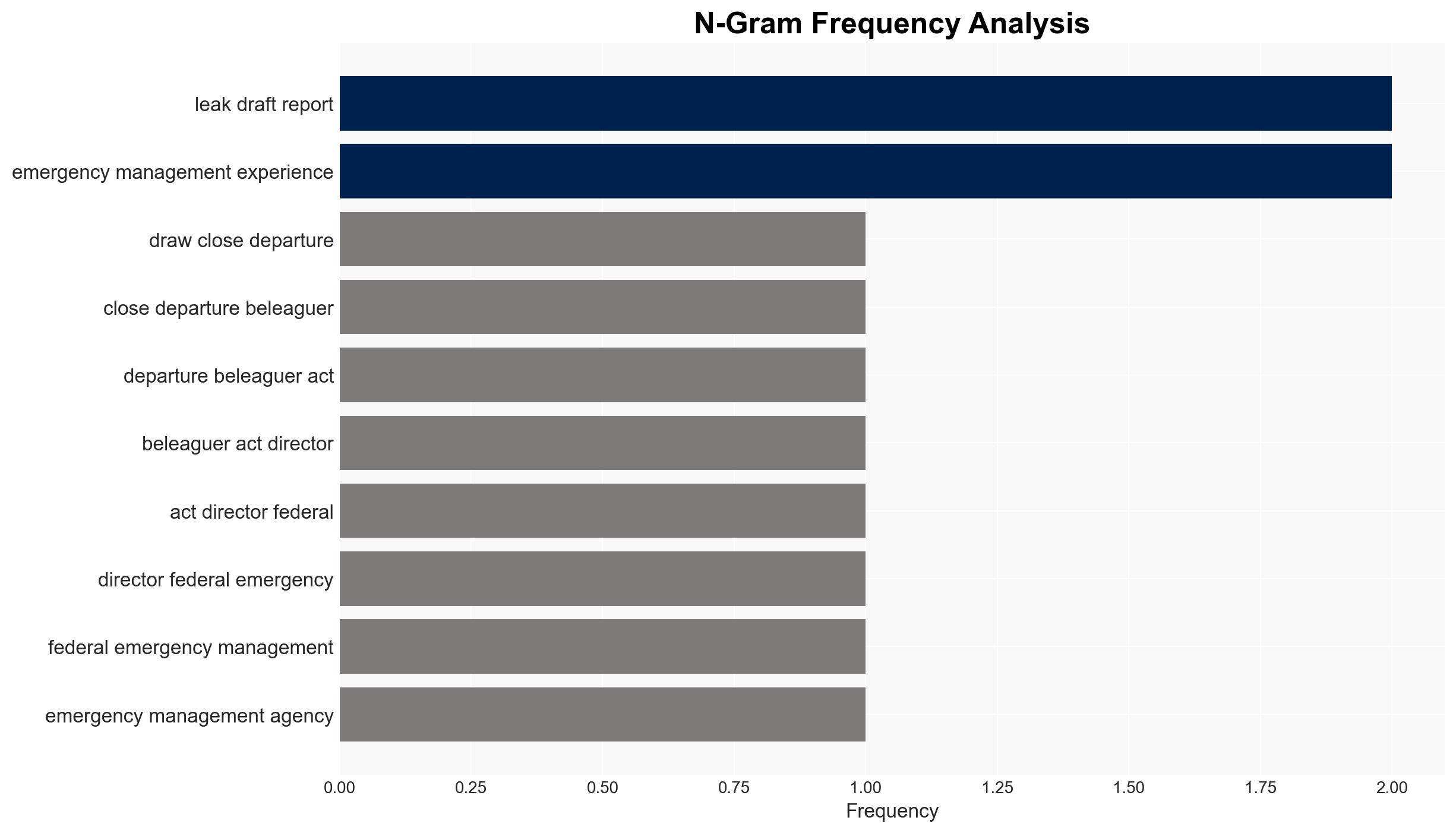FEMA Faces Challenges Amid Leadership Changes and Proposed Workforce Reductions in Turbulent Year
Published on: 2025-11-26
AI-powered OSINT brief from verified open sources. Automated NLP signal extraction with human verification. See our Methodology and Why WorldWideWatchers.
Intelligence Report: FEMAs terrible horrible no good very bad year
1. BLUF (Bottom Line Up Front)
The Federal Emergency Management Agency (FEMA) is experiencing significant operational and leadership challenges, exacerbated by political pressures and administrative changes. The most likely hypothesis is that FEMA will undergo structural reforms but face continued instability in the short term. This situation affects national disaster response capabilities and could have broader implications for public safety. Overall confidence in this assessment is moderate.
2. Competing Hypotheses
- Hypothesis A: FEMA will be disbanded or significantly downsized, as initially suggested by the Trump administration. Supporting evidence includes the administration’s proposal for staffing cuts and the leaked draft report recommending agency reform. However, contradicting evidence includes the draft report’s recommendation to preserve the agency and elevate it to a cabinet-level department.
- Hypothesis B: FEMA will undergo reform and restructuring to improve efficiency and maintain its role in disaster management. Supporting evidence includes the draft report’s recommendation to preserve and reform the agency and the introduction of a bipartisan bill to elevate FEMA’s status. Contradicting evidence includes the lack of a permanent director and ongoing leadership instability.
- Assessment: Hypothesis B is currently better supported due to the draft report’s recommendations and legislative efforts to reform and elevate FEMA. Indicators that could shift this judgment include changes in political will, further leadership instability, or significant operational failures.
3. Key Assumptions and Red Flags
- Assumptions: FEMA’s operational challenges are primarily due to leadership instability and political pressures; the draft report accurately reflects current reform intentions; legislative support for FEMA reform will persist.
- Information Gaps: Details of the final report by the review council; the full scope of FEMA’s internal challenges; the impact of leadership changes on operational capability.
- Bias & Deception Risks: Potential bias in reporting due to political agendas; risk of underestimating internal FEMA capabilities or overestimating political support for reform.
4. Implications and Strategic Risks
The ongoing challenges within FEMA could lead to reduced disaster response effectiveness, affecting public safety and trust in government capabilities. Over time, this may influence broader political dynamics and public perception of government efficiency.
- Political / Geopolitical: Potential for increased political debate over federal disaster management roles and responsibilities.
- Security / Counter-Terrorism: Reduced disaster response capabilities could indirectly affect national security by straining resources during concurrent emergencies.
- Cyber / Information Space: Limited direct implications, but potential for misinformation or disinformation campaigns exploiting FEMA’s challenges.
- Economic / Social: Inefficient disaster response could lead to higher economic costs and social unrest in affected regions.
5. Recommendations and Outlook
- Immediate Actions (0–30 days): Monitor legislative developments and leadership changes within FEMA; engage with key stakeholders to assess reform progress.
- Medium-Term Posture (1–12 months): Develop resilience measures to mitigate potential gaps in disaster response; strengthen partnerships with state and local emergency management agencies.
- Scenario Outlook: Best: Successful reform and improved FEMA efficiency; Worst: Disbandment or severe downsizing leading to inadequate disaster response; Most-Likely: Incremental reforms with ongoing leadership challenges.
6. Key Individuals and Entities
- David Richardson – Acting Director, FEMA
- Kristi Noem – Homeland Security Secretary
- Karen Evans – New Interim Director, FEMA
- Jeffrey Schlegelmilch – Director, National Center for Disaster Preparedness
- Cameron Hamilton – Proposed FEMA Leader
7. Thematic Tags
National Security Threats, This brief is tagged under: national security threats; cybersecurity; counter-terrorism; regional focus; disaster management; federal agency reform; political dynamics; public safety
Structured Analytic Techniques Applied
- Cognitive Bias Stress Test: Expose and correct potential biases in assessments through red-teaming and structured challenge.
- Bayesian Scenario Modeling: Use probabilistic forecasting for conflict trajectories or escalation likelihood.
- Network Influence Mapping: Map relationships between state and non-state actors for impact estimation.
Explore more:
National Security Threats Briefs ·
Daily Summary ·
Support us





